|
|
|
|
|
|
 |
While empirical data is lacking on what percentage of families choose unlined graveboxes versus burial vaults, conservative estimates place it at 50/50 or perhaps even higher toward unlined outer burial containers (OBCs). However, a study of families who indicated a preference for burial over cremation revealed a higher preference for burial vaults once they were educated on the differences.
Key findings by independent research firm Product Acceptance & Research (PAR) were: |
-
Most families do not know the difference between aburial vault and a grave box
Consumers were initially asked if they knew the difference between a burial vault and a grave box. Seventy-eight percent responded that they did not know the difference. |
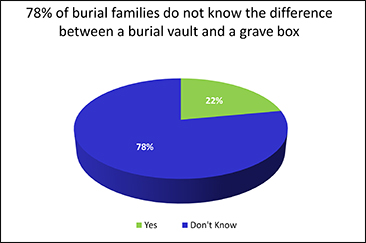 |
|
-
After basic education, just 17% chose a grave box
After watching a two-minute educational video explaining the purpose of an outer burial container and the differences between unlined grave boxes and burial vaults, only seventeen percent said they would choose a grave box. Fifty-seven percent stated a preference for a burial vault. Twenty-six percent were not yet ready to make a choice, stating the need for additional information including costs and options. |
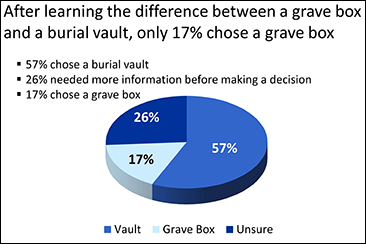 |
|
-
68% were interested in personalization of the burial vault
The choice of personalization was striking particularly given that there was no presentation of costs in the survey. Indeed, some respondents expressed the desire to understand if and how much personalization might cost before they would state a preference – and yet this might be interpreted still as interest. |
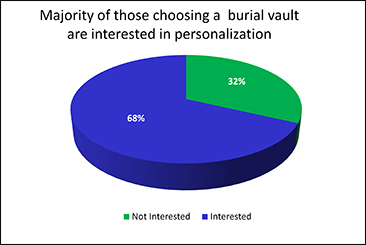 |
|
The key takeaway from this study is the prudence of educating families. It’s probably safe to say that most people want to make educated decisions, and arguably, educated decisions are better decisions.
For those concerned about “selling” to families, educating is not selling, and there are numerous tools available to help objectively educate. Wilbert has complimentary videos you can download from our website and there are other great tools that you can get through your local Wilbert Licensee.
|
 |
 |
Wayne Stellmach is Director of Marketing for Wilbert Funeral Services, Inc. |
|
|
|
|
|
|
 |
|
|
In the last article, I discussed two Search Engine Optimization (SEO) elements – page titles and navigation menus – that help your website get noticed by search engines like Google. In this issue, we’ll specifically talk about three more ways that you can improve your rank and ultimately increase website visitors.
As with the previous tips, you should be able to check these things–and fix them– through your Content Management System (CMS). Or, simply pass the punch list to your web developer to implement.
1 Use your keyword(s) or search term in headings (H1s).
A “Heading 1” style (commonly referenced simply as an “H1”) is visible on the webpage itself, often as the main heading at the top of the page. To maximize search results, an H1 should only be used once on the page and should always contain the keyword.
Also, if a page is missing an H1 or has the main header not specifically flagged as an H1, your page will be “dinged” by Google. In other words, make sure to not only create headers and subheads using keywords but also ensure you use the proper H1 and H2 tools to flag them so Google can classify them and know they are important. Just changing font size and colors will not have the same impact and is not the recommended approach.
The H1 is often just the keyword itself. As Google “crawls” your site, the Header 1 provides details about the role of that specific page and it helps determine how and when your site will be found and under what circumstances.
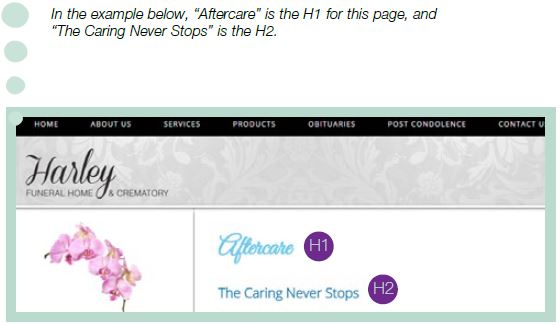 |
|
|
|
2 Use your keyword(s) or search term in subheads (H2s).
The Heading 2 or simply H2 is the secondary heading and can be used more frequently. It is a sub-heading used to divide or categorize chunks of text. Like the H1, it’s important that the keyword shows up in H2s too… and you can have as many H2s per page as you want without any repercussions from Google. In fact, multiple H2s are encouraged from an SEO standpoint and from a visitor-readability perspective as well.
If you want to optimize “burial services,” sample sub-headings for H2s could read, “What you need to know about burial services” or “Learn about our burial services.” By using variations of the keywords in your pages’ H2s, Google knows that the term is used with emphasis throughout the page.
3 Have your hyperlinks reflect the keyword(s).
Fundamentally, each website is a collection of pages. Links to other pages of your site – called “internal links” – help search engines learn how your site is structured, how the pages connect and what the entire site contains. If a page isn’t connected to other pages, it’s an “orphan” that Google will devalue significantly.
|
The “how to” here is fairly simple. If you’re writing a page that mentions a product or service, add links to those pages at the first mention.
This example shows how to hyperlink words within the text.
These are just a few of the things that you can do to help Google find your site–which can boost your web presence. In the next article, we’ll learn how to optimize images to boost your search efforts. |
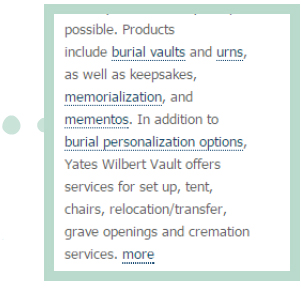 |
|
 |
 |
Lisa Anderson is the founder of Peacock Marketing Group in Greenville, SC and manages websites, SEO, and email campaigns for over 50 Wilbert licensees and funeral homes. www.peacockmarketing.net |
|
|
|
|
|
|
|
|
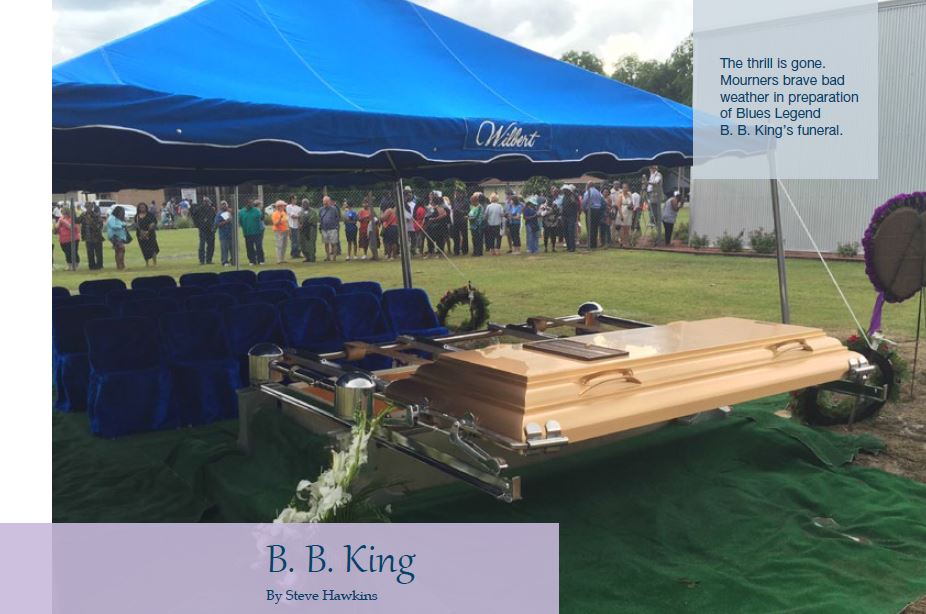 |
|
|
Fans bestowed upon B.B. King the honorary title “King of the Blues,” although he never referred to himself as that according to his closest friends. Still, B.B. King was considered to be the best in his field. He and his famed Gibson guitar, “Lucille,” thrilled and entertained audiences as well as influenced generations of not only blues musicians but rock and country artists throughout the world. He passed away on May 14, 2015 in Las Vegas at the age of 89. B.B. King was a legend.
The famed blues guitarist’s funeral service was held in a standing-room-only sanctuary at Bell Grove Missionary Baptist Church in his hometown of Indianola, Mississippi, with several dignitaries in attendance. From the church the procession was led by an honor guard, two white horses, a black horse carrying his guitars, and the hearse with his casket. He was buried at the B.B. King Museum and Delta Interpretive Center, which opened in 2008 to tell his life’s story. The museum will develop a memorial garden, with benches and a water wall, around the gravesite to befit the talented musical icon.
Darwin May, general manager of the Wilbert Burial Vault Company out of Jackson, Mississippi, recounts, “When the funeral home contacted us about the family request for a Wilbert vault, and the funeral director asked my opinion on which one and said they wanted the best, without hesitation I said, ‘Wilbert Bronze.’ It definitely was an honor to represent Wilbert on a funeral of that magnitude for one of the greatest blues musicians to ever live.”
And while everyone in the Wilbert Licensee network is saddened by the death of this incredibly talented man, we are honored that we were allowed to take a small role in handling his service. One newspaper from as far away as Great Britain reported in its article on the service how Wilbert Funeral Services laid straw on the wet ground for the mourners. And Mississippi Governor Phil Bryant and others asked what kind of vault it was upon seeing the Wilbert Bronze their native son was about to be laid in.
“Commemorating Life with Respect” is not just a motto but the way the Wilbert family of Licensees conducts itself every day. Whether the deceased was a celebrity or a middle-income grandmother of nine from Enid, Oklahoma, Licensees can be counted on to provide the same compassionate, professional service. The “Wilbert Way” is something everyone associated with the network takes great pride in.
 |
 |
Steve Hawkins is Marketing Specialist for Wilbert Funeral Services, Inc. |
|
|
|
|
|
|
|
|
|
|
|
 |
A few weeks ago I traveled to Clemson, South Carolina, to watch my son who is a freshman at the University of Texas compete in the 2015 National Collegiate Triathlon Championship. For me it was two days of nonstop energy−if you enjoy watching 1,200 college athletes from 192 different colleges compete−for the athletes it was two long, rainy days grueling of competition for the title of National Champions.
Over the course of the competition I watched over a dozen college triathletes who were not able to complete the swim portion of the triathlon get pulled from the lake and into a rescue boat either due to lack of physical conditioning or, in most cases, a minor panic attack. For me the thought of drowning is something I fear, even though I consider myself a decent swimmer. When I hear about an accidental drowning on the news, I can’t help but think about the person and their struggle to survive in the water and the family left behind to wonder what happened, or worse, the guilt they might have if it was a child in their own swimming pool or bathtub.
Recently the local lake near my house had two adult bodies float up on shore a week apart that were suspected to have died from drowning. Our lake attracts a lot of fisherman who are often seen in their boats alone fishing until dark, which can cause trouble if there is any type of accident or health issues. Studies have found natural water, like rivers, lakes and the ocean, were the most common spots for drowning.
Many people would never dream that drowning is a leading cause of accidental death for children 5 years and younger according to a study from the CDC report ranging from 1999 to 2010. During those 12 years, more than 46,000 people died from drowning, an average of nearly 4,000 each year, or about 10 a day.
As embalmers, drowning cases present a lot of variables, and several approaches can be used to treat the drowning victim based on where the death occurred and how long the person |
was in the water prior to being found. For the sake of this article we will assume the death occurred in a lake or river.
Typically a drowning victim will float face down in the water, increasing the likelihood of dark coloring in the face from the blood settling in the face along with extreme swelling. These two challenges can cause embalmers to quickly suggest a closed casket to the family. I have found bleaching the facial area with X-Tone and, assuming the person is autopsied, I would suggest raising both carotid arteries and using the restricted cervical injection to prevent further swelling in the face. A high-strength fluid such as Pierce’s TraumaCare in waterless solution strength of 2.5% or higher to ensure preservation demands are met.
In addition to arterial injection, the embalmer should hypo inject the areas the fluid did not reach or where the fluid had minimal results. Other major concerns are purge, viscera gas, skin slip, and bacteria in the nasal and oral cavity. Swabbing the nose and packing the mouth with Chlorasan is also a good safety measure. The degree of severity will depend greatly on the amount of time the person was in the water. The best advice I have always been told is “it is better to be safe than sorry.”
Yes, I admit it; it is easier to “powder and bag them,” but as professional embalmers we need to always go the extra mile for the families we have been trusted to serve. With cremation rates raising every year, our ability to create value in viewing will determine if embalming will sink or swim.
 |
 |
Lance Ray is COO of Pierce Chemical in Dallas, TX. |
|
|
|
|
|
|
|
|
|
|
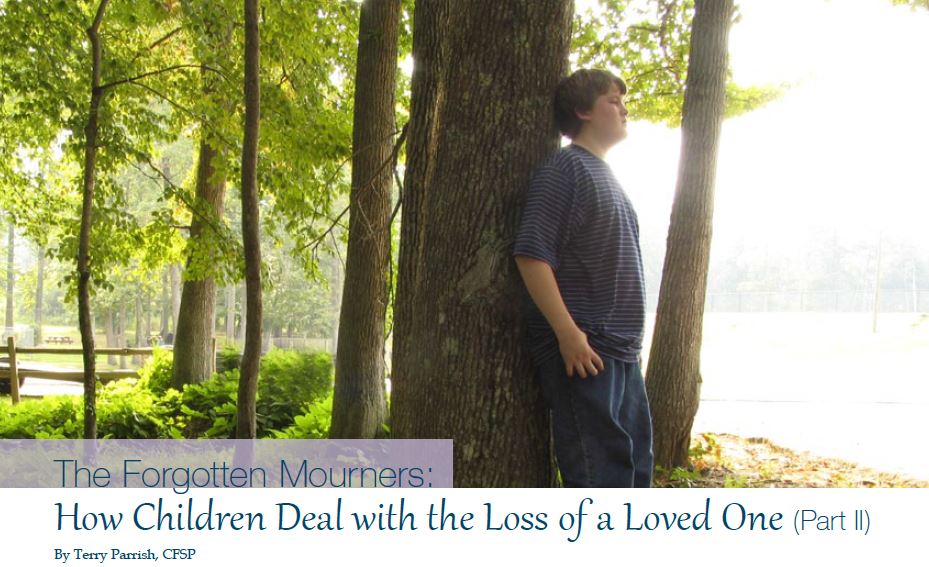 |
In Part I of this article, we talked about the process of mourning and grief in younger children. Now we will discuss the needs and responses of teenagers to the death of a parent and some of the ways counselors help all children deal with their grief and mourning.
Adolescents are particularly vulnerable to the death of a loved one. As teenagers go from childhood to adulthood, they experience many emotional, physical, and social changes. Inability to deal with emotions accompanying the loss of a parent may result in severe consequences for them, including clinical depression, suicidal attempts, delinquent behavior, and addictions.
Mourning is an essential, psychological task of adolescence. During teenage years, a young adult deals with mood changes and depressive states. Teenagers have the need to become more independent and self-reliant. Parental loss in adolescence is an obstacle to normal development of a teenager. In particular, the death of a parent may trigger earlier conflicts that a teenager experienced and suppressed. For example, if a teenager had problems with aggressive behavior, the death of a parent may intensify this conduct.
Adolescents mourn in a way that is unpredictable and inconsistent. Their most common response is escape, which is frequently accompanied with anxiety and confusion. Being already overwhelmed with their new social roles, teenagers may fail to cope with loss of the loved one, unless they are provided with proper assistance and support, particularly by a surviving parent.
Adolescents tend to isolate their thoughts about the death of a parent, being more focused on their own depressive moods. Teenagers often do not entirely accept the irreversible nature of the loss, similar to preschool-aged children. Also, a teenager may idealize the deceased parent and direct all the inner rage at the surviving parent. Unlike adults, teenagers are reluctant to express their feelings about the loss of a parent in an open way. At the same time, effective coping with bereavement during adolescent years results in greater maturity. The key to maturity is effective coping.
The main purpose of grief and mourning counseling is to help a person respond to the death of the loved one and the accompanying stress. One of the best models widely used in grief counseling is the transitional-events model, which says bereavement is a process consisting of several stages. This specifically focuses on children, risk factors, and resilience, and calls for targeted counseling for children who are at risk by reinforcing protective factors (presence of a surviving parent, specifically). In addition, this model also suggests that the success of a child’s adjustment is shaped by the events that follow the death of a parent. It also emphasizes a child’s selfesteem and coping skills. The primary goal of the transitional-events model is to decrease the impact of stressful events following the death of a parent on a child.
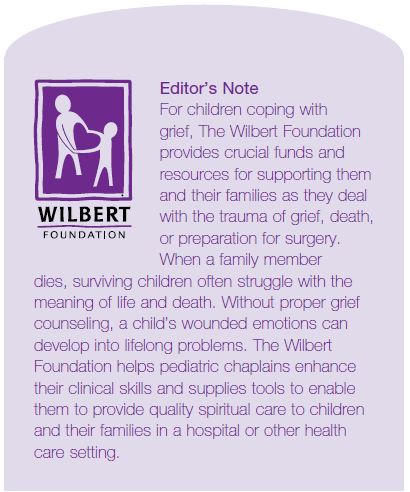 |
The death of a parent makes a child feel helpless. The adaptive-controls model is specifically useful in helping children who witnesses the deadly disease of a parent and were aware of the upcoming, tragic outcome. It helps prepare children for the death of a parent before the sad event occurs. If a child is aware that a parent is terminally ill, a child is also aware that he/she cannot control things and may develop negative selfevaluations. The goal here is to empower children and redirect their attention on events they can control. In particular, children who experience the death of a parent tend to assume that it is their job to take care and reduce the sadness of a surviving parent. This approach calls for collaboration between a parent and a child, where both of them are guided through the experience of the loss. A child is informed that a parent has the power to manage his distress, while a child is assisted withadjustment. It is important that a surviving parent does not create additional emotional pressure on a child.
With the accommodation model the emphasis is made on redistribution of family tasks and roles, including emotional ones, among surviving members. This urges age-appropriate reassignment of roles to support normal childhood development. In particular, children should be given a chance to live through their normal childhood experiences, while teenagers should be supported in resuming connection with peers. In other words, the purpose of grieving and mourning is to help surviving family members return to their normal life paths.
Finally, special attention should be devoted to the models that are entirely focused on needs and skills of grieving children. A grieving child is helped with acquiring skills needed to cope with stressful situations. This is used by counselors working with children who are in the process of grieving following the death of a parent as well as with children who live with a terminally ill family member. Adolescents who are prepared to deal with stressful events were more successful in going through mourning and less likely to engage in self-destructive behaviors compared to those teenagers who did not receive coping skills counseling.
In conclusion, mourning and grief are normal reactions of a person to death of the loved one. The death of a parent is a tragic event for a person of any age, whereas a child--whether a preschooler or a teenager--is particularly affected by the loss. The important thing is to be aware that children are going through a difficult time too. Just as you, a funeral professional, might recommend counseling for a grieving adult, keep in mind the children and their struggles. There are school counselors, religious groups, therapists, mental help groups, and others in your area who are willing to step in so that the child’s needs are tended too as well.
 |
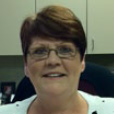 |
Terry Parrish, CFSP, is Registrar/Director of Admissions for Dallas Institute of Funeral Service in Dallas, TX. |
|
|
|
|
|
|
|
|
 |
Solve the puzzle for a chance at a $25 American Express® Gift Card!
Print out your puzzle, complete and fax to: 708-865-1646. The first person to correctly solve the puzzle and fax the solution will win. The 100th correct fax will receive a $25 AMEX Gift Card, too! And, to make it even more interesting, we will draw a fax from all those sent to receive a third $25 AMEX Gift Card. The winners will be announced in our next edition of the Updater. Good luck!
|
Updater Winter Puzzle Winners!
#1 - Kevin Frank
Frank Funeral Home
10 2nd Ave SE
Lidgerwood, ND 58053
#100 - Deborah Fails
Crosier Pearson Cleburne
Funeral Home
512 N Ridgeway Dr.
Cleburne, TX 76033
Random - David Mardis
Schaeffer Mortuary
6 N. Main St.
Caldwell, KS 67022
|

The Wilbert Updater is published for employees and friends of Wilbert Funeral Services, Inc. NO part of this publication may be reproduced, in whole or in part, without written permission from Wilbert Funeral Services, Inc.
News, comments, and story ideas can be sent to:
Editor – Wilbert Updater
2913 Gardner Road | Broadview, Illinois 60155
888.WILBERT (945-2378) | 708.865.1600
|
|
|
|
|
|
|
|
|